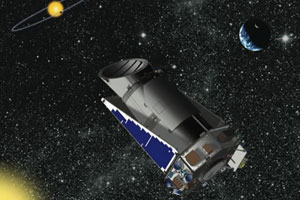 For several years there has been a lot of buzz about the detection of extra-solar planets, or exoplanets: planets orbiting stars other than our Sun. However, due to the limits in technology and observational capabilities, to date only large, gas giant planets orbiting close to the stars (so called "Hot Jupiters") have been found, with a possible exception or two.
For several years there has been a lot of buzz about the detection of extra-solar planets, or exoplanets: planets orbiting stars other than our Sun. However, due to the limits in technology and observational capabilities, to date only large, gas giant planets orbiting close to the stars (so called "Hot Jupiters") have been found, with a possible exception or two.
The main method for detecting exoplanets is by spectroscopically observing a tiny "wobble" in a star caused by the gravitational tug of a massive planet in orbit. Only Jupiter-sized planets have enough pull to produce a wobble in their star that we can detect—and the closer they are to their star, the shorter their orbital period and the more wobbles we can measure in a given period of time. The gravity of an Earth-sized planet is too feeble for this and planets at Earth-like distance orbit only once in many months.
But NASA is about to launch a new spacecraft, Kepler, whose mission is to detect Earth-sized planets at Earth-like distances from their stars. Kepler will launch on March 5th, and will eventually move into an orbit around the Sun. In essence, Kepler is a giant space camera designed to "stare" at a chosen patch of the sky continuously for years to come.
So what exactly is Kepler looking for in its unblinking stare contest with the stars in its vision? Kepler won’t be looking for microwobbles in those stars. Kepler will detect planets through the transit method. A transit is when a planet crosses in front of its star, blocking off a tiny amount of the star's light for a time.
A number of the hot Jupiters have been detected by their transits across their stars: a large planet can block a measurable amount of their star's light. But the drop in a star's brightness caused by an Earth-sized planet is far smaller—and if that planet only orbits its star every year or so, with its infrequent transit lasting only a few hours, an observer would have to stare long and hard to notice it.
